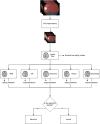Validation of an autonomous artificial intelligence-based diagnostic system for holistic maculopathy screening in a routine occupational health checkup context
- PMID: 35567610
- PMCID: PMC9477940
- DOI: 10.1007/s00417-022-05653-2
Validation of an autonomous artificial intelligence-based diagnostic system for holistic maculopathy screening in a routine occupational health checkup context
Abstract
Purpose: This study aims to evaluate the ability of an autonomous artificial intelligence (AI) system for detection of the most common central retinal pathologies in fundus photography.
Methods: Retrospective diagnostic test evaluation on a raw dataset of 5918 images (2839 individuals) evaluated with non-mydriatic cameras during routine occupational health checkups. Three camera models were employed: Optomed Aurora (field of view - FOV 50º, 88% of the dataset), ZEISS VISUSCOUT 100 (FOV 40º, 9%), and Optomed SmartScope M5 (FOV 40º, 3%). Image acquisition took 2 min per patient. Ground truth for each image of the dataset was determined by 2 masked retina specialists, and disagreements were resolved by a 3rd retina specialist. The specific pathologies considered for evaluation were "diabetic retinopathy" (DR), "Age-related macular degeneration" (AMD), "glaucomatous optic neuropathy" (GON), and "Nevus." Images with maculopathy signs that did not match the described taxonomy were classified as "Other."
Results: The combination of algorithms to detect any abnormalities had an area under the curve (AUC) of 0.963 with a sensitivity of 92.9% and a specificity of 86.8%. The algorithms individually obtained are as follows: AMD AUC 0.980 (sensitivity 93.8%; specificity 95.7%), DR AUC 0.950 (sensitivity 81.1%; specificity 94.8%), GON AUC 0.889 (sensitivity 53.6% specificity 95.7%), Nevus AUC 0.931 (sensitivity 86.7%; specificity 90.7%).
Conclusion: Our holistic AI approach reaches high diagnostic accuracy at simultaneous detection of DR, AMD, and Nevus. The integration of pathology-specific algorithms permits higher sensitivities with minimal impact on its specificity. It also reduces the risk of missing incidental findings. Deep learning may facilitate wider screenings of eye diseases.
Keywords: Age-related macular degeneration; Artificial intelligence; Diabetic retinopathy; Retinography; Screening.
© 2022. The Author(s).
Conflict of interest statement
MA. Zapata is the founding member and medical director of Optretina. D. Royo is founding partner and technical director of the company. O. Font is employed in Optretina and A. Bures and C. Salinas work as fundoscopy reader in the company. The authors declare no other direct financial conflicts of interest as individuals.
Figures



Similar articles
-
Cross-camera Performance of Deep Learning Algorithms to Diagnose Common Ophthalmic Diseases: A Comparative Study Highlighting Feasibility to Portable Fundus Camera Use.Curr Eye Res. 2023 Sep;48(9):857-863. doi: 10.1080/02713683.2023.2215984. Epub 2023 May 29. Curr Eye Res. 2023. PMID: 37246918
-
Development of an artificial intelligence system to classify pathology and clinical features on retinal fundus images.Clin Exp Ophthalmol. 2019 May;47(4):484-489. doi: 10.1111/ceo.13433. Epub 2018 Nov 15. Clin Exp Ophthalmol. 2019. PMID: 30370587
-
Validation of Deep Convolutional Neural Network-based algorithm for detection of diabetic retinopathy - Artificial intelligence versus clinician for screening.Indian J Ophthalmol. 2020 Feb;68(2):398-405. doi: 10.4103/ijo.IJO_966_19. Indian J Ophthalmol. 2020. PMID: 31957737 Free PMC article.
-
Artificial intelligence in ophthalmology.Rom J Ophthalmol. 2023 Jul-Sep;67(3):207-213. doi: 10.22336/rjo.2023.37. Rom J Ophthalmol. 2023. PMID: 37876505 Free PMC article. Review.
-
Promising Artificial Intelligence-Machine Learning-Deep Learning Algorithms in Ophthalmology.Asia Pac J Ophthalmol (Phila). 2019 May-Jun;8(3):264-272. doi: 10.22608/APO.2018479. Epub 2019 May 31. Asia Pac J Ophthalmol (Phila). 2019. PMID: 31149787 Review.
Cited by
-
Application of artificial intelligence system for screening multiple fundus diseases in Chinese primary healthcare settings: a real-world, multicentre and cross-sectional study of 4795 cases.Br J Ophthalmol. 2024 Feb 21;108(3):424-431. doi: 10.1136/bjo-2022-322940. Br J Ophthalmol. 2024. PMID: 36878715 Free PMC article.
-
Evaluation of the Performance of a 3D-Printed Smartphone-Based Retinal Imaging Device as a Screening Tool for Retinal Pathology in Mozambique.Am J Trop Med Hyg. 2023 Oct 9;109(5):1192-1198. doi: 10.4269/ajtmh.23-0378. Print 2023 Nov 1. Am J Trop Med Hyg. 2023. PMID: 37918001 Free PMC article.
-
Artificial Intelligence and Occupational Health and Safety, Benefits and Drawbacks.Med Lav. 2024 Apr 24;115(2):e2024014. doi: 10.23749/mdl.v115i2.15835. Med Lav. 2024. PMID: 38686574 Free PMC article.
References
MeSH terms
LinkOut - more resources
Full Text Sources
Medical

